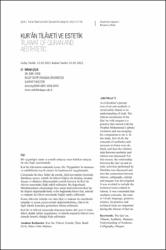| dc.contributor.author | Çelik, İmran | |
| dc.date.accessioned | 2023-03-01T08:28:51Z | |
| dc.date.available | 2023-03-01T08:28:51Z | |
| dc.date.issued | 2022 | en_US |
| dc.identifier.citation | Çelik, İ. (2022). Kur’ân tilâveti ve estetik, 58(1), 127-158. | en_US |
| dc.identifier.issn | 1300-8498 | |
| dc.identifier.issn | 2822-2261 | |
| dc.identifier.uri | https://dergipark.org.tr/tr/pub/did/issue/69077/895597 | |
| dc.identifier.uri | https://hdl.handle.net/11436/7739 | |
| dc.description.abstract | Bir uygarlığın sanat ve estetik anlayışı onun hakikat anlayışı
ile sıkı ilişki içerisindedir.
Kur’ân tilâvetinin makamla icrası, Hz. Peygamber’in okuması
ve sahâbîlerini teşvik etmesi ile başlamış bir uygulamadır.
Çalışmada ilk önce İslâm’da estetik, ölçü kavramları üzerinde
durulmuş ayrıca, estetik ile tilâvet ilişkisi ele alınmış, insanın
duygu ve düşünce dünyasındaki estetik hissiyat ile Kur’ân
tilaveti arasındaki ilişki tahlil edilmiştir. Bu doğrultuda
Müslümanların oluşturduğu bazı sanat faaliyetlerinin Kur’ân
ile ilişkisi değerlendirilmiş ve bu bağlamda hüsn-i hat, mûsikî
ve makam ile tilâvet arasındaki bağlar analiz edilmiştir.
Konu, tilâvetin özünde var olan ölçü ve makam ile estetikteki
tenasüp ve uyum çerçevesinde değerlendirilmiş, tilâvet ile
ilgili teknik konulara girmekten imtina edilmiştir.
Kur’ân’ın tilâveti esnasında okuyanın beden dili, jest ve mimikleri, dudak talimi uygulaması ve teknik araçların tilâveti icra
etmede önemli olduğu ifade edilmiştir. | en_US |
| dc.description.abstract | A civilization’s perception of art and aesthetic is
inextricably linked to its
understanding of truth. The
tilawat (recitation) of the
Qur’an with maqam is a
practice that started with the
Prophet Mohammad’s (pbuh)
recitation and encouraging
his companions to do it. In
the study, first of all, the
concepts of aesthetics and
measure in Islam were defined, and then the relationship between aesthetic and
tilawat was discussed. For
this reason, the relationship
between the Qur’an and artistic activities performed by
Muslims was discussed and
also the connection between
tilawat, calligraphy, mūsīqī
and maqam was investigated.
It was avoided to include the
technical issues related to
tilawat. It was concluded that
aesthetic concerns, the reader’s body language, gestures,
mimics, lip practice and
technical tools are important
during the tilawat of Qur’an. | en_US |
| dc.language.iso | tur | en_US |
| dc.rights | info:eu-repo/semantics/openAccess | en_US |
| dc.subject | Kur’ân | en_US |
| dc.subject | Tilâvet | en_US |
| dc.subject | Estetik | en_US |
| dc.subject | Ölçü | en_US |
| dc.subject | Bediî zevk | en_US |
| dc.subject | Hüsn-i hat | en_US |
| dc.subject | Makam | en_US |
| dc.subject | The Qur’an | en_US |
| dc.subject | Tilawat | en_US |
| dc.subject | Aesthetic | en_US |
| dc.subject | Measure | en_US |
| dc.subject | Understanding of Aesthetic | en_US |
| dc.subject | Calligraphy | en_US |
| dc.subject | Maqam | en_US |
| dc.title | Kur’ân tilâveti ve estetik | en_US |
| dc.title.alternative | Tilawat of Quran and aesthtetic | en_US |
| dc.type | article | en_US |
| dc.contributor.department | RTEÜ, İlahiyat Fakültesi, Temel İslam Bilimleri Bölümü | en_US |
| dc.contributor.institutionauthor | Çelik, İmran | |
| dc.identifier.volume | 58 | en_US |
| dc.identifier.issue | 1 | en_US |
| dc.identifier.startpage | 127 | en_US |
| dc.identifier.endpage | 158 | en_US |
| dc.relation.journal | Diyanet İlmi Dergi | en_US |
| dc.relation.publicationcategory | Makale - Uluslararası Hakemli Dergi - Kurum Öğretim Elemanı | en_US |


















